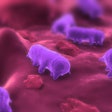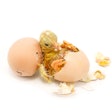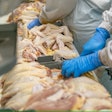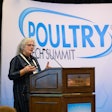
Since July of 2018, the U.S. turkey industry has dealt with an ongoing outbreak of Salmonella Reading. So far, the issue is yielding more questions than answers for the industry as well as food safety and regulatory authorities.
The pathogen and the current situation
Salmonella Reading is a serotype of the microbe Salmonella enterica enterica, according to Dr. Colin Basler, a veterinary epidemiologist at The Centers for Disease Control and Prevention (CDC). This serotype of Salmonella is also classified as being multidrug resistant meaning it is resistant to a number of antimicrobials, too. However, there are still several drugs available that are effective in treating ill patients.

Dr. Colin Basler, The Centers for Disease Control and Prevention | Courtesy of the Centers for Disease Control and Prevention
In an interview, Basler said the CDC first noticed people getting sick at the end of November 2017 and formally began an investigation of the Salmonella Reading outbreak in February 2018. As of April 1, 2019, the CDC tracked 279 reported cases of Salmonella Reading across 41 states. So far, these cases resulted in 107 hospitalizations and one death.
The CDC is one of the numerous federal agencies working in concert with state governments to control the outbreak. It is working alongside the U.S. Department of Agriculture’s (USDA) Food Safety and Inspection Service (FSIS) and its Animal and Plant Health Inspection Service (APHIS) as well as the U.S. Food and Drug Administration (FDA).
Where exactly this serotype of Salmonella came from is a mystery. Basler said it’s been detected before multiple times in the past 20 years and it can be found in a variety of animals. However, this current outbreak is associated with turkeys. How that happened is currently unknown.
The products making people sick
Evidence gathered by the CDC and FSIS suggests the outbreak is associated specifically with raw turkey products. The outbreak is not limited to a single source, either. As of February 2019, 22 slaughter facilities and seven processing facilities tested positive for the pathogen.
Four product recalls were ordered specifically because of Salmonella Reading. Two were conducted by raw dog food manufacturers in Minnesota in February 2018 and January 2019, respectively. Two were conducted by Jennie-O Turkey Store, the nation’s second-largest turkey producer, in November and December of 2018. Those recalls included 311,486 pounds of raw ground turkey.
Hormel Inc., Jennie-O’s parent company, did not respond to a request for comment on this article. Nevertheless, Jennie-O President Steve Lykken did comment on the recall during a company earnings call in December 2018.

So far, two recalls of raw ground turkey meat were conducted due to contamination with Salmonella Reading. (treb2864 | Bigstock.com)
“We have been working with others in the industry on the issue of Salmonella Reading for some time,” Lykken said at the time. “Given the fact that there are only a few sources of turkey inputs such as eggs, turkeys and genetic stock to the majority of large turkey companies in the industry, we know this is a much bigger issue that will require the entire industry to eradicate this strain from the turkey supply.”
Lykken also said the company was adding new steps to its live operations including vaccinating turkeys against Salmonella, improving farm practices and banning Salmonella Reading eggs, turkeys and genetic stock from a provider known to be positive for Salmonella Reading.
“Unfortunately, Salmonella Reading may continue to be found throughout the industry until all companies take the steps necessary to eliminate it from the system,” Lykken said during the call. “The turkey industry has been working together for many years to reduce Salmonella. Despite these efforts, this particular Salmonella strain can be found in 29 different manufacturing plants from 19 different companies, according to government agencies.”
The response to the outbreak
Due to the nature of the outbreak, containing and stopping Salmonella Reading requires a coordinated effort among the turkey industry. A great deal of those coordination efforts fall to the National Turkey Federation (NTF).
In an interview, NTF President Joel Brandenberger said the Washington-based industry group started tracking the problem from the first dog food recall in early 2018 and it has focused on dealing with and containing the serotype since learning of the outbreak investigation in July 2018.

Joel Brandenberger, The National Turkey Federation | Courtesy of the National Turkey Federation
In short, he said, the industry has yet to find a comprehensive solution to the problem. It is trying a number of responses at every step in the production and processing cycle. He could not disclose what specifically is being done, he said because the measures are only in the trial stages, the industry needs freedom to try every option available and he did not want to give the impression that the industry is on the verge of a breakthrough.
Controlling Salmonella and teaching food safety
The NTF’s general strategy for dealing with the outbreak at this point is two pronged. First, it wants the industry to focus on containing both Salmonella Reading and Salmonella in general. Second, it wants to educate consumers on how best to protect themselves from foodborne illness.
Beyond the mystery surrounding the origin of Salmonella Reading’s presence in turkeys, some of the frustration comes from the outbreak going against the industry’s progress in reducing Salmonella prevalence. Brandenberger said Salmonella prevalence is about 2% on whole turkeys and the prevalence is slightly higher on ground turkey products. That’s less than half of the prevalence when the USDA's FSIS started sampling for the bacteria in the 1990s.
Despite this, the presence of the Salmonella Reading challenge and the number of unknowns surrounding the serotype is pushing the industry to further intensify its efforts to control all Salmonella.
On the consumer end, the NTF is making a serious push for consumers to practice basic food safety measures in the kitchen. This includes avoiding cross contamination, proper hygiene and sanitation and thoroughly cooking all turkey to an internal temperature of 165 degrees Fahrenheit (73.9 C) before eating and proper storage of raw and cooked turkey.
Is there an end in sight?
It’s difficult to say how soon the outbreak may end or be declared under control. Basler said because the serotype is not located at a single source nor is it a specific avian disease outbreak, a level of containment cannot be quantified.
Brandenberger said the NTF will continue to coordinate constant, confidential communication among the industry about the problem and encourage its members to try every possible approach to stop the outbreak.
At this stage, however, FSIS testing is still finding Salmonella Reading in some plants. But, he said, the federal government seems confident in the ongoing extensive collaboration between government and industry.
“There are a handful of things out there that we think are encouraging that we think may have some effect, but it’s just too early to see any clear results either in industry testing or in the government’s testing to know for sure that this is the (solution),” Brandenberger said. “I just don’t want to get anyone prematurely excited about where we are nor, frankly, unnecessarily pessimistic. We are very encouraged by the pace at which the industry is working.”
















